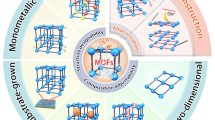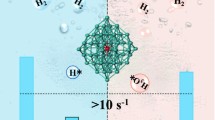Abstract
Electrochemical water splitting for the hydrogen production is now widely considered as a prominent technology to alleviate the energy crisis, due to its green, high efficiency, and low energy consumption. However, the slow kinetic rate of anodic oxygen evolution (OER) has hindered its further development. Therefore, it is of great significance to develop low cost and non-precious catalysts. Metal-organic framework materials (MOFs) are widely considered appropriate candidates for serving as OER catalysts because of their diverse composition, abundant pores, high specific surface area, and well-defined metal centers. However, MOFs usually suffer from the disadvantages of low electrical conductivity and slow mass transfer. To overcome these shortcomings, we herein propose a facile defect engineering strategy to obtain a class of advanced MOF-based OER electrocatalysts, where the NiFe-MIL-D@NF with abundant surface defects is demonstrated to be highly active toward OER, delivering a current density of 100 mA·cm−2 with the overpotential of merely 394 mV, along with outstanding electrochemical stability. This work reports a facile defect engineering strategy towards the modification of MOF-based electrocatalysts, which will guide the further development of more advanced OER electrocatalysts.










Similar content being viewed by others
Data availability
The results/data/figures in this manuscript have not been published elsewhere, nor are they under consideration by another publisher. The corresponding author declares that all the data and materials are available.
References
Xu H, Zhao Y, Wang Q, He G, Chen H (2022) Supports promote single-atom catalysts toward advanced electrocatalysis. Coord Chem Rev 451:214261
Xu H, Zhao Y, He G, Chen H (2022) Race on engineering noble metal single-atom electrocatalysts for water splitting. Int J Hydrog Energy 47(31):14257–14279
Liu Z, Yu X, Xue H, Feng L (2019) A nitrogen-doped CoP nanoarray over 3D porous Co foam as an efficient bifunctional electrocatalyst for overall water splitting. J Mater Chem A 7(21):13242–13248
Li D, Liu H, Feng L (2020) A review on advanced FeNi-based catalysts for water splitting reaction. Energy Fuel 34(11):13491–13522
Tian L, Liu Y, He C, Tang S, Li J, Li Z (2023) Hollow heterostructured nanocatalysts for boosting electrocatalytic water splitting. Chem Rec 23(2):e202200213
Lu X, Wang T, Cao M, Cheng W, Yang H, Xu H, He C, Tian L, Li Z (2023) Homogeneous NiMoO4–Co(OH)2 bifunctional heterostructures for electrocatalytic oxygen evolution and urea oxidation reaction. Int J Hydrog Energy. https://doi.org/10.1016/j.ijhydene.2023.04.257
Lu X, Du M, Wang T, Cheng W, Li J, He C, Li Z, Tian L (2023) Ultrafast fabrication of nanospherical CoFe alloys for boosting electrocatalytic water oxidation. Int J Hydrog Energy. https://doi.org/10.1016/j.ijhydene.2023.05.105
Xu H, Yuan J, He G, Chen H (2023) Current and future trends for spinel-type electrocatalysts in electrocatalytic oxygen evolution reaction. Coord Chem Rev 475:214869
Tian L, Huang Z, Lu X, Wang T, Cheng W, Yang H, Huang T, Li T, Li Z (2023) Plasmon-mediated oxidase-like activity on Ag@ZnS heterostructured hollow nanowires for rapid visual detection of nitrite. Inorg Chem 62:1659–1666
Chu X, Wang K, Qian W, Xu H (2023) Surface and interfacial engineering of 1D Pt-group nanostructures for catalysis. Coord Chem Rev 477:214952
Chu X, Wang L, Li J, Xu H (2023) Strategies for promoting catalytic performance of Ru-based electrocatalysts towards oxygen/hydrogen evolution reaction. Chem Rec 23:e202300013
Xu H, Wang C, Huang B, Shang H, Du Y (2023) Dual-cation doping precisely reducing the energy barrier of the rate-determining step for promoting oxygen-evolving activity. Inorg Chem Front 10(7):2067–2074
Xu H, Jin L, Wang K, Yang L, He G, Chen H (2023) Carbon nanocages confined multicomponent phosphide heterostructures for boosting oxygen evolution reaction in alkaline water and seawater. Int J Hydrog Energy. https://doi.org/10.1016/j.ijhydene.2023.05.254
Xu H, Wang C, He G, Chen H, Du Y (2022) Hierarchical hollow CoWO4-Co(OH)2 heterostructured nanoboxes enabling efficient water oxidation electrocatalysis. Inorg Chem 61(35):14224–14232
He Q, Hu H, Shao Y, Tang D, Zhao Z (2022) Constructing 3D hierarchical MOFs nanospheres for oxygen evolution from high-throughput calculations. J Colloid Interface Sci 607(Pt 2):1944–1952
Xiao L, Wang Z, Guan J (2022) 2D MOFs and their derivatives for electrocatalytic applications: recent advances and new challenges. Coord Chem Rev 472:214777
Lu XF, Fang Y, Luan D, Lou XWD (2021) Metal-organic frameworks derived functional materials for electrochemical energy storage and conversion: a mini review. Nano Lett 21(4):1555–1565
Zhu Y, Yue K, Xia C, Zaman S, Yang H, Wang X, Yan Y, Xia BY (2021) Recent advances on MOF derivatives for non-noble metal oxygen electrocatalysts in zinc-air batteries. Nano Lett 13(1):137
Xiao X, Zou L, Pang H, Xu Q (2020) Synthesis of micro/nanoscaled metal-organic frameworks and their direct electrochemical applications. Chem Soc Rev 49(1):301–331
Thangavel P, Lee H, Kong TH, Kwon S, Tayyebi A, Lee JH, Choi SM, Kwon Y (2022) Immobilizing low-cost metal nitrides in electrochemically reconstructed platinum group metal (PGM)-free oxy-(hydroxides) surface for exceptional OER kinetics in anion exchange membrane water electrolysis. Adv Energy Mater 13(6):2203401
McCrory CCL, Jung S, Peters JC, Jaramillo TF (2013) Benchmarking heterogeneous electrocatalysts for the oxygen evolution reaction. J Am Chem Soc 135(45):16977–16987
Thangavel P, Ha M, Kumaraguru S, Meena A, Singh AN, Harzandi AM, Kim KS (2020) Graphene-nanoplatelets-supported NiFe-MOF: high-efficiency and ultra-stable oxygen electrodes for sustained alkaline anion exchange membrane water electrolysis. Energy Environ Sci 13(10):3447–3458
Li FL, Wang P, Huang X, Young DJ, Wang HF, Braunstein P, Lang JP (2019) Large-scale, bottom-up synthesis of binary metal-organic framework nanosheets for efficient water oxidation. Angew Chem Int Ed 58(21):7051–7056
Li FL, Shao Q, Huang X, Lang JP (2018) Nanoscale trimetallic metal-organic frameworks enable efficient oxygen evolution electrocatalysis. Angew Chem Int Ed 57(7):1888–1892
Dutta S, Indra A, Feng Y, Song T, Paik U (2017) Self-supported nickel iron layered double hydroxide-nickel selenide electrocatalyst for superior water splitting activity. ACS Appl Mater Interfaces 9(39):33766–33774
Li X, Han GQ, Liu YR, Dong B, Hu WH, Shang X, Chai YM, Liu CG (2016) NiSe@NiOOH core-shell hyacinth-like nanostructures on nickel foam synthesized by in situ electrochemical oxidation as an efficient electrocatalyst for the oxygen evolution reaction. ACS Appl Mater Interfaces 8(31):20057–20066
Tang C, Cheng N, Pu Z, Xing W, Sun X (2015) NiSe nanowire film supported on nickel foam: an efficient and stable 3D bifunctional electrode for full water splitting. Angew Chem Int Ed 54(32):9351–9355
Xu H, Yang L, Wang K, Jin L, Liu Y, He G, Chen H (2023) Etched high-entropy prussian blue analogues as trifunctional catalysts for water, ethanol, and urea electrooxidation. Inorg Chem 62:11271–11277
Tian L, Pang X, Xu H, Liu D, Lu X, Li J, Wang J, Li Z (2022) Cation-anion dual doping modifying electronic structure of hollow CoP nanoboxes for enhanced water oxidation electrocatalysis. Inorg Chem 61(42):16944–16951
Xu H, Li J, Chu X (2023) Intensifying hydrogen spillover for boosting electrocatalytic hydrogen evolution reaction. Chem Rec 23(3):e202200244
Xu H, Li J, Chu X (2023) Interfacial built-in electric-field for boosting energy conversion electrocatalysis. Nanoscale Horiz 8(4):441–452
Bu L, Ning F, Zhou J, Zhan C, Sun M, Li L, Zhu Y, Hu Z, Shao Q, Zhou X, Huang B, Huang X (2022) Three-dimensional porous platinum-tellurium-rhodium surface/interface achieve remarkable practical fuel cell catalysis, Energy. Environ Sci 15:3877–3890
Wang M, Wang M, Zhan C, Geng H, Li Y, Huang X, Bu L (2022) Ultrafine platinum-iridium distorted nanowires as robust catalysts toward bifunctional hydrogen catalysis. J Mater Chem A 10(36):18972–18977
Xu H, Wang K, He G, Chen H (2023) Concurrent alloying and vacancy engineering for intensifying hydrogen spillover towards alcohol–water co-electrolysis. J Mater Chem A 11(33):17609–17615
Xu H, Wang K, Jin L, Yang L, Yuan J, Zhang W, He G, Chen H (2023) Synergistically engineering of vacancy and doping in thiospinel to boost electrocatalytic oxygen evolution in alkaline water and seawater. J Colloid Interface Sci 650(Pt B):1500–1508
Kundu A, Kuila T, Murmu NC, Samanta P, Das S (2023) Metal-organic framework-derived advanced oxygen electrocatalysts as air-cathodes for Zn-air batteries: recent trends and future perspectives. Mater Horiz 10(3):745–787
Zhang L, Wang J, Jiang K, Xiao Z, Gao Y, Lin S, Chen B (2022) Self-reconstructed metal-organic framework heterojunction for switchable oxygen evolution reaction. Angew Chem Int Ed 61(51):e202214794
Madhu R, Sankar SS, Karthick K, Karmakar A, Kumaravel S, Kundu S (2021) Electrospun cobalt-incorporated MOF-5 microfibers as a promising electrocatalyst for OER in alkaline media. Inorg Chem 60(13):9899–9911
Guo Y, Huang Q, Ding J, Zhong L, Li T-T, Pan J, Hu Y, Qian J, Huang S (2021) CoMo carbide/nitride from bimetallic MOF precursors for enhanced OER performance. Int J Hydrog Energy 46(43):22268–22276
Chen H, Yu Z, Hou Y, Jiang R, Huang J, Tang W, Cao Z, Yang B, Liu C, Song H (2021) Double MOF gradually activated S bond induced S defect rich MILN-based Co(z)-NiMoS for efficient electrocatalytic overall water splitting. Nanoscale 13(48):20670–20682
Hou CC, Zou L, Wang Y, Xu Q (2020) MOF-mediated fabrication of a porous 3D superstructure of carbon nanosheets decorated with ultrafine cobalt phosphide nanoparticles for efficient electrocatalysis and zinc-air batteries. Angew Chem Int Ed 59(48):21360–21366
Wang HF, Chen L, Pang H, Kaskel S, Xu Q (2020) MOF-derived electrocatalysts for oxygen reduction, oxygen evolution and hydrogen evolution reactions. Chem Soc Rev 49(5):1414–1448
Funding
This work is supported by the start-up funding to H. Xu by Changzhou University (ZMF22020055), Advanced Catalysis and Green Manufacturing Collaborative Innovation Center, Changzhou University for financial support, Changzhou University College Students Innovation and Entrepreneurship Training Program (QZX23020158, QZX23020211). We also thanked the Analysis and Testing Center of Changzhou University for the assistance in characterizations.
Author information
Authors and Affiliations
Contributions
Kun Wang: conceptualization, methodology, formal analysis, investigation, and writing. Jian Kang: conceptualization, methodology, formal analysis, and investigation. Lei Jin, Lida Yang, and Yang Liu: resources, data curation, and investigation. Yahan Li and Guanyu Chen: data curation and formal analysis. Hui Xu: writing, review, editing, and project administration.
Corresponding author
Ethics declarations
Ethical approval
This work is not applicable to both human and/or animal studies.
Competing interests
The authors declare no competing interests.
Additional information
Publisher’s Note
Springer Nature remains neutral with regard to jurisdictional claims in published maps and institutional affiliations.
Rights and permissions
Springer Nature or its licensor (e.g. a society or other partner) holds exclusive rights to this article under a publishing agreement with the author(s) or other rightsholder(s); author self-archiving of the accepted manuscript version of this article is solely governed by the terms of such publishing agreement and applicable law.
About this article
Cite this article
Wang, K., Kang, J., Jin, L. et al. Defect engineering of MOF toward enhanced electrocatalytic water oxidation. Ionics 29, 5397–5403 (2023). https://doi.org/10.1007/s11581-023-05213-6
Received:
Revised:
Accepted:
Published:
Issue Date:
DOI: https://doi.org/10.1007/s11581-023-05213-6




